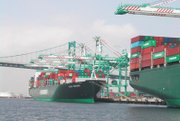Customs Investigating Apparel Smuggled Into United States
Customs officials are searching for the exporter of more than 200 containers of apparel that were classified as furniture parts and toys before being shipped to the ports of Los Angeles and Long Beach.
The goods, sent from Hong Kong and Shanghai, were seized at the ports some time in April when U.S. customs officials learned that the clothing had been deliberately classified as furniture parts and toys to avoid tariffs and evade apparel quotas that apply to China until the end of 2008. The apparel was destined for several different retail and manufacturing clients throughout the United States.
In late April and early May, enforcement officials began sending a slew of questionnaires to retailers and manufacturers expecting to receive the landed-duty-paid (LDP) goods in time for the summer season.
Customs officials would not talk about the case until anindictment came down from the U.S. Attorney’s office. “It is an open and ongoing investigation by U.S. Immigration and Customs Enforcement,” said Virginia Kice, an ICE spokeswoman.
Several customs attorneys throughout Los Angeles have been busy helping their clients fill out questionnaires that should help investigators locate the people who sent the goods. Investigators do not believe the recipients of the apparel were part of the importing scheme.
“We know there was a search warrant executed against a warehouse in Los Angeles,” said Richard Wortman, a Los Angeles customs attorney. “There were about 200 containers of merchandise seized that were sent LDP. Furniture parts were one of the things they were classified as. They are duty-free items.”
Toys, another duty-free classification, were listed as the contents on some of the 200 containers, customs brokers said.
According to various sources, some of the goods were immediately detained. Others were followed to their destination so investigators could locate the importers and question them.
“They are contacting people to find the source of the goods,” said John Pellegrini, a New York customs attorney representing several apparel clients who have been questioned. “It’s another situation of foreign interests trying to skirt duties.”
Jonathan Fee, a Washington, D.C., customs attorney, said some of his clients had ordered the apparel goods from Chinese factories. “The goods were from the Far East,” Fee acknowledged. “The allegations are that the middleman misclassified the merchandise to pay a lower duty and keep the money.”
FOB vs. LDP
Customs officials have repeatedly warned apparel importers that it is wiser to ship their goods on a free-on-board basis, or FOB, rather than LDP. With FOB, importers arrange their own shipping and payment of duties and have more knowledge of what is put on the shipping manifests. With LDP, the foreign manufacturer is the one who takes care of the shipping and tariff payment duties and delivers the goods to the importer’s door.
During recent trips to Los Angeles, Janet Labuda, director of the textile enforcement and operations division at U.S. Customs and Border Protection, told apparel and textile importers that most smuggling schemes involve LDP shipments. Labuda referred all calls on the case to ICE.
The current case is another version of a major apparel smuggling incident that took place at the ports of Los Angeles and Long Beach between 2000 and 2002, when as many as 5,000 containers of clothing shipped from Hong Kong were smuggled into the United States, even though their destination was listed as Mexico.
During that operation, sealed containers came in through the ports of Los Angeles and Long Beach. U.S. customs officials did not inspect the containers because they were supposed to be going to Mexico. Instead, the containers were transferred to in-bond warehouses, where they awaited truck transportation to Mexico. In an indictment, the U.S. Attorney’s office said that at some point someone changed the paperwork for the containers and replaced the high-security seals with low-security domestic seals to disguise the content of the containers. Instead of heading south to Mexico, the goods detoured to stores throughout the United States.
Government officials estimated that the 5,000 containers of smuggled apparel had a value of $418 million. Many of the smugglers in that case were never apprehended.
No one has estimated the value of the various clothing items inside the 200 containers recently detained by customs officials.
Even if no U.S. retailers or manufacturers are involved in the scheme, it could pose a problem for people importing Chinese- made apparel under quota. If the apparel items are released into the country, importers could suddenly see a change in the quota-fill rate.
“The worst thing that could happen is that one day the quota is at 57 percent filled and the next day it is filled because CITA [Committee for the Implementation of Textile Agreements, a government agency] added the smuggled goods to the quota,” said Robert Krieger, president of Norman Krieger Inc., a Los Angeles customs broker and freight forwarder with many apparel clients. “It would be an awful scenario for importers.”






















